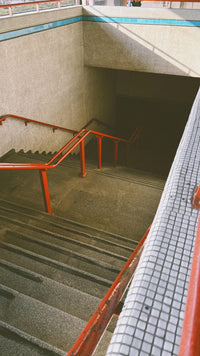Before we get into the exact dimensions, let’s talk about what a stair landing is and why it matters. A landing is just a flat, level space at the top, bottom, or middle of a staircase- it gives you a place to step safely before continuing up or down. Whether it’s a small platform at your front steps or a larger one on a long staircase, it’s there to make moving around safer and more comfortable.
Purpose of a Stair Landing
Safety
Landings aren’t just a random design choice- they’re placed where they are for a reason, especially on tall staircases. If a staircase is too long, walking up or down in one go can be tiring, and if you trip, there’s a bigger chance of a serious fall. A landing breaks up the stairs into shorter sections, giving you a safe, level spot to pause if you need to. It also helps catch you if you do stumble, stopping a fall from turning into a long, dangerous tumble.
Transition
Landings make moving through a space feel natural and easy. If a staircase changes direction, a landing gives you a level surface to turn without awkwardly twisting on a step. Even on straight stairs, it acts as a break between floors, making the transition from one level to another smoother.
Access
Sometimes, a landing isn’t just helpful- it’s necessary. If a staircase leads to a doorway, hallway, or another space, you need a flat, stable surface to step onto before entering. Without a landing, you'd be trying to open a door while balancing on a step, which isn’t just inconvenient- it’s a safety risk.
Key Considerations for Stair Landing Dimensions
Width
The width of a stair landing should always match the width of the stairs, at the very least. In many cases, landings are even wider, especially in U-shaped staircases where the landing needs extra room for turning. The same goes for grand entryways or commercial buildings where wider landings improve accessibility and traffic flow.
In some rare cases, a landing might be slightly narrower than the stairs, but this is usually only allowed in tight spaces where building codes permit it. Even then, it should never be too small to safely step onto, as that defeats the purpose of having a landing in the first place.
Depth
The depth of a stair landing- measured in the direction you’re walking- should be at least 48 inches or equal to the width of the stairs, whichever is less. In U-shaped staircases, landings are often much deeper to allow for an easy and natural turn without feeling cramped.
Even with depth, there are some exceptions. In tight residential spaces or areas with design constraints, some codes allow a slightly smaller landing, as long as it’s still safe to use. Another exception is exterior stairs, like those leading to a small porch or deck, where space might be limited. In these cases, the landing might be shallower, but it still has to meet the minimum safe depth for stepping and turning.
Level Surface
A landing needs to be completely level to provide a stable and natural place to step. Even a small slope can throw off your balance, making it uncomfortable or even unsafe to use. That’s why the maximum allowable slope is 1:48- just enough to allow for slight drainage on outdoor landings without creating a noticeable tilt.
This is especially important if you’re planning a stair project, whether for a home, business, or outdoor space. If a landing is uneven, you’ll feel it immediately- it can make stepping feel unnatural and increase the risk of trips or falls.
Measuring and Building a Stair Landing
Measure the Width and Depth
We already covered what to consider when it comes to width and depth, but before you make any final decisions, check your local building codes to make sure your landing meets all requirements. Once you know the rules, triple-check your measurements.
Additional Tips for Stair Safety
Handrails
Always consider installing handrails on your landings- most of the time, they just continue naturally from the stairs. If the landing isn’t closed off by a wall on one side, having handrails on both sides isn’t just a good idea- a must for safety. They provide extra support, especially for kids, older adults, or anyone who might need a little help with balance. Plus, they help guide movement, making the whole staircase feel more secure and comfortable to use.
Lighting
Also, a great tip - make sure your stairways and landings are well-lit to prevent missteps. It also makes the space feel more inviting and easier to navigate. With modern options like motion-sensor lights, LED strips, or recessed lighting, you can keep things bright without sacrificing style.
Visual Contrast
Not many people consider this, but I think it’s a useful tip - by highlighting step edges, you make going up and down more comfortable while also clearly marking the beginning and end of the landing. A simple contrast in color or material can make a big difference, especially in low-light conditions or for people with vision impairments.
Conclusion
Whether you're designing a new staircase or renovating an old one, getting the stair landing dimensions right is key to safety, comfort, and usability. From proper depth and width to ensuring level surfaces and solid handrail support, every detail matters. A well-planned landing doesn't just meet code, it makes your space more functional and secure.
If you’re planning a stair project and want expert help or need quality materials, browse our handrail collection or contact us directly. We’re here to help you build safely and beautifully.









